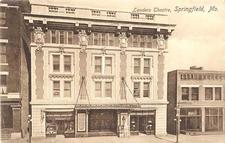Early Movie Theaters
 Springfield Leader, 24 July 1927, page 1.
Springfield Leader, 24 July 1927, page 1.
First motion pictures brought to Springfield in 1906 by showmen
"Motion pictures are now the feature attraction at each of Springfield's half dozen show houses. A quarter of a century ago they were unknown and only a few residents here had even seen a moving picture. Twenty-one years ago, early in 1906, the first picture came to Springfield, brought by a pair of roving showmen who were forced to leave after a few months because it was not a paying proposition.
"These pioneer motion picture operators are now unknown. Nobody remembers even their names. They set up their little hand-operated projecting machine in a vacant storeroom next door to the old Baldwin Theater, on St. Louis Street, where the McDaniel building now stands. Their pictures were only one and two reels in lengh usually wild western thrillers as the feature picture in two reels, with a one-reel slapstick, pie throwing comedy as an added attraction.
"Interest died and with it the crowds after curiosity had subsided. The room contained only 150 seats and an admission price of 10 cents was charged. Then the two adventurers moved on to some other town.
"It was not surprising that the first attempt to bring moving pictures to Springfield was unsuccessful, according to N. J. Cunningham, who now occupies the position of being the oldest motion picture operator in Springfield. The first pictures were very unsatisfactory. They were streaked and 'rainy', they flickered and blurred on the screen. They were continually halted by breaks in the film and trouble with the machine. People were not satisfied. They came once but did not come again, after their curiosity had been satisfied.
"The St. Louis street attempt was followed soon after by a show house on College Street, across from the fire department run by 'Cap' Peabody, combining pictures and vaudeville in the theater called at various times the Mecca, Electric, Peoples and other names. The Gem theater, across from the Metropolitan Hotel, also owned by 'Cap' Peabody, took up the new pictures.
"In 1909, within a few months of each other, three houses opened on South Avenue within a few blocks of each other. One was started by the firm of Levy, Doggrell & Balsley in a building where the Tuttle-Scott shoe store now stands. Another was opened on the northwest corner of South Avenue and Walnut Street by Mick Hayes and the third, which finally survived and acquired the distinction of being Springfield’s first successful motion picture theater, was built by D. J. Fox and was called the Aladdin and stood where the Brownie Book store now is.
"The first two lived only a short time. The Alladin, soon purchased by H. S. Gardner, became a very popular place. He later got into a controversy with the electric light company and lost his ownership.
"It was then taken over by H. M. Thomas and L. W. Seaman. In 1910 Mr. Seaman sold his interests to N. H. Cunningham and in 1911 Thomas & Cunningham sold out to Levy, Doggrell & Balsley.
"Thomas & Cunningham arranged for the establishment of the Jefferson Theater and started operating in September 1911. They had taken over the present site of the Jefferson which formerly had been a skating ring, then a garage. The building on Jefferson Avenue was acquired and used as a lobby and entrance as at present. The building proper is of course far back from the street and would have been practically worthless had it not been turned into a theater.
"W. W. Smith opened the Grand at the southeast corner of the square in 1910. The Star at 321 Boonville Avenue also was opened in 1910 by George Olendorf.
"The north side Princess, then on the south side of Commercial Street, the second door east of Benton Avenue, was opened by a group of north side business men as a civic pride enterprise. It was taken over eventually by S. E. Wilhoit, who built the present Princess in 1917, discontinuing the old Princess.
"The old Diemer Theater, over the Prescott laundry, showed pictures occasionally, but was more of a play house.
"The Alhambra opened in 1915 in the Elks Arcade where the Piggly-Wiggly store now operates but lived only a short time. The Electric opened in 1917 at its present location. The Aladdin was discontinued at the time the Electric opened.
"The Landers was built in 1908 a year after the old Baldwin burned but has been showing pictures only during the last few years.
"Mr. Cunningham pointed out a number of the old stars of the first pictures shown in Springfield, many of whom are still prominent. 'Those were the days', Mr. Cunningham said, 'when Charlie Chaplin, Fatty Arbuckle, John Bunny, Alice Joyce, Maurice Costello, Mary Pickford, Julia Gordon, Margaret Clark and other old stars were getting their start. The slapstick pie-throwers usually appeared at the College Street theaters.’
"H. M. Thomas, one of the pioneer theater operators who showed moving pictures to Springfield fans, now is with the Paramount Pictures Corporation at Toronto, Canada, Mr. Cunningham said."
Find this article at http://thelibrary.org/blogs/article.cfm?aid=1828&lid=35